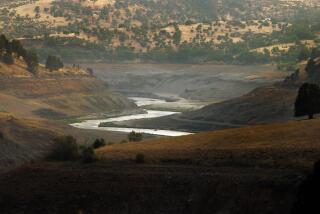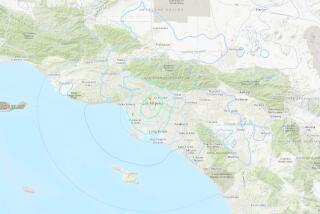Op-Ed: With disasters rocking the state, California needs to remember the St. Francis Dam failure
There is a quiet campaign underway in northern L.A. County that deserves the support of people across California.
The Santa Clarita Valley Historical Society is pushing for the site of the St. Francis Dam to be declared a national memorial. The designation would commemorate both the dam and the more than 400 lives that were lost when it collapsed, the worst man-made disaster in California history.
The St. Francis Dam was squeezed into San Francisquito Canyon, about 20 miles north of what is now the city of Santa Clarita. Construction began in early 1925 and was completed in May 1926. Built to hold back some 12 billion gallons of water, the structure was more than 200 hundred feet tall and more than 1,200 feet wide.
About two years after it was finished, on March 12, 1928, just before midnight, the dam failed. Water had saturated a portion of the foundation underlying the dam, causing “uplift,” which expanded and destabilized its main concrete structure.
California has much to learn from the terrible legacy of the St. Francis Dam, particularly at a moment when disasters are once again rocking the state.
When the dam gave way, it let loose a 100-foot wall of water that raged for hours through the Santa Clara River Valley, blasting through Saugus, Piru, Bardsdale, Fillmore, Santa Paula, Ventura and other communities. The torrent morphed quickly into a flood not just of water but of concrete, asphalt, railroad rails and ties, farms, cars and homes. This gargantuan flow of debris was an equal-opportunity killer.
The first victims were city of Los Angeles employees. Lilian Curtis, who was several months pregnant, narrowly escaped after climbing a nearby hill while carrying her 3-year-old son. Her husband, Lyman, who worked for the Bureau of Power and Light, and two young daughters were all carried off.
A 12-year-old boy named Louis Rivera experienced something similar near Castaic Junction. Awakened by the rumble of the approaching water, he managed to grab his younger brother and sister and get them to higher ground. He watched helplessly as his mother and older brother got swept away.
There are dozens more stories like these. And there are no stories at all for the many victims who remain unidentified more than 90 years later.
The St. Francis Dam calamity has largely been forgotten, even though it is part of a larger saga that Los Angeles cannot help but remember.
The dam was built as a vital extension of the Los Angeles Aqueduct, the lifeline that continues to bring water more than 200 miles from the Owens Valley.
The project was the brainchild of William Mulholland, who at the 1913 opening of his “Big Ditch” said famously of the water that came cascading through its sluice gates: “There it is, take it.”
After the dam burst — an engineering failure for which Mulholland was largely responsible — he uttered a similarly terse statement during a coroner’s inquest: “The only ones I envy about this thing are the ones who are dead.”
In history and popular culture (most notably in the film “Chinatown”), the main victims of L.A.’s thirst for unbridled growth are the residents of the Owens Valley, the people whose water and land the city acquired by hook and by crook.
But the Santa Clara River Basin made sacrifices every bit as worthy of commemorative recognition.
The St. Francis Dam calamity is an event of national importance as well. The accident imperiled the Boulder Canyon Project Act — the legislation that authorized the building of the Hoover Dam.
Enter the Fray: First takes on the news of the minute from L.A. Times Opinion »
To secure passage of the bill in the wake of the tragedy, California Gov. C.C. Young and other Hoover Dam boosters waged an effective campaign that the country needed more, not fewer, dams like the St. Francis. They stressed that its failure was an aberration, the result of specific engineering errors made by Mulholland. Progress in California and the American West, they argued, meant learning from — but also forgetting about — the collapse of the St. Francis Dam.
Today, a different piece of legislation, the Saint Francis Dam Disaster National Memorial Act, could ensure that the episode is better remembered. The bill was passed by the House of Representatives last year. Should it pass in the Senate, where it was recently advanced by the Committee on Energy and Natural Resources, it will return to the House for a second vote. Then it will need to be signed by President Trump.
Living in California means living close to the beauty and power of nature. It also means understanding that we will pay a price when our supposed control of nature fails.
California has much to learn from the terrible legacy of the St. Francis Dam, particularly at a moment when disasters are once again rocking the state. Congress and the president should move quickly to make the bill law.
Erik Altenbernd is an assistant professor of history at College of the Canyons in Santa Clarita. William Deverell is a professor of history at USC and the director of the Huntington-USC Institute on California and the West.
Follow the Opinion section on Twitter @latimesopinion or Facebook
More to Read
A cure for the common opinion
Get thought-provoking perspectives with our weekly newsletter.
You may occasionally receive promotional content from the Los Angeles Times.










